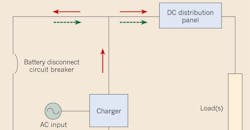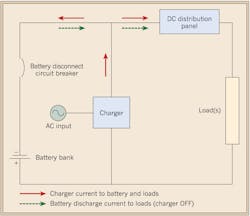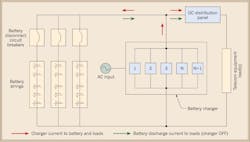Because stationary batteries and 48VDC power systems serve as lifelines for telecommunication networks, the reliability of these systems is of the utmost importance. Many system designers rely on circuit breakers in these battery circuits to serve as the protection and isolating device. For multi-string battery plants, the trend is to provide a disconnect circuit breaker for each battery string, rather than using a common breaker for the entire battery bank. Individual circuit breakers help isolate the faulty string, allowing maintenance personnel to take out one battery string at a time.
Associated with high discharge and charging currents, the batteries in these systems can also generate high fault current. From an electrical design point of view, determining the rating of the disconnect circuit breaker and conductor size in the battery circuit poses a real challenge to the system designer. Proper understanding of the complete DC system is essential in selecting the correct rating of circuit breaker and conductor size to provide a reliable and safe installation.
Configuration of telecom DC power systems
Figure 1 depicts the block diagram of a battery-powered DC system. The main components are the battery, battery disconnect circuit breaker, charger-rectifier, and the distribution board that supplies DC power to the loads, apart from metering and the AC distribution unit. The battery and charger are connected in parallel with the load, meaning they're always online.
Under normal conditions, the battery mode is in standby (secondary) while the prime power source (AC power system) provides electrical energy to the loads. In standby mode, the battery plant does not discharge its DC energy but maintains itself at fully charged condition by consuming a very small amount of DC current. When the prime power source is severed or the flow of rectifier DC power is interrupted, the battery instantaneously becomes the prime source of power for the loads, allowing no interruption of power to the loads. The battery reserve (backup time) usually ranges from 2 to 8 hours and is user-specified in accordance with the specific needs of the facility.
Due to the recent advancement of battery and charger technology, many plant design variations are possible. Flexibility for future increased capacity requirement (due to increased DC load) with minimal plant modifications is becoming a design requirement.
Battery plant
Vented (commonly called wet or flooded) or valve-regulated (commonly referred to as sealed) lead-acid batteries are normally used as the backup power source for telecom power systems, due to their low operating costs. The battery string is comprised of 24 series-connected battery cells to make 48V. The battery plants are normally designed to support the telecom load to a final battery voltage of 1.75V/cell.
Proper design of a battery system is essential to ensure reliable protection of critical telecom loads. Apart from battery sizing for the load demand, redundancy is important when critical loads are to be supported. A single battery string leaves the critical load unsupported if one cell were to fail. Therefore, a reliable battery system requires building in redundancy rather than simply oversizing the battery.
It's preferable to have a system with two or more equal-rated parallel strings of batteries. Some systems can have as many as 20 parallel strings to support the high steady-state current requirement. The system is designed to allow one string of batteries to be disconnected for maintenance purposes and still support the full load current with a shorter reserve time. However, for not so critical loads, a single battery string may be used, especially when an emergency backup generator is available onsite.
Each battery string is provided with a separate disconnect circuit breaker, which serves to isolate the faulty battery string during overcurrent conditions and prevents problems in the string from affecting the other strings, chargers, circuit cables, and connected DC load.
Battery charger/rectifier
New compact, modular-switched mode rectifiers in battery chargers provide high capacity in small packages and enable easy upgradeability. For the most reliable system, the charger system is designed to have equally sized parallel rectifiers in N+1 redundant configuration — N of which is adequate to carry the total system load current.
During operating conditions, the parallel rectifiers provide the current consumed by the load, the float current for the batteries, and the additional current for recharging the batteries after a mains outage. A redundant charger-rectifier fills two needs: battery recharging after a mains outage and continued operation if one rectifier fails.
Figure 2 shows a typical telecom DC power system with multi-string batteries and N+1 chargers. The operating scenarios with respect to the battery circuit current are summarized in the Table.
Battery circuit protective device and conductor sizing
The NEC deals with the minimum requirements for sizing the conductors and overcurrent devices to protect the conductors, but not for protecting the battery. The battery circuit breaker is normally installed to provide both disconnect and protection capabilities. The operating philosophy of the DC power system determines the design and type of overcurrent protection used. Knowledge of circuit breakers for overcurrent protection and their ratings that are available for DC application are also essential.
The continuous current rating of the conductor and circuit breaker in the battery circuit are based upon the worst-case current to or from the battery, whichever is higher. This current is determined by analyzing the battery charging and discharging scenarios, as noted in the Table. The breaker trip setting must be greater than the anticipated continuous current. Industry standards suggest increasing this value by 25% to arrive at the protection rating. The conductor ampacity rating is also based on 125% of the continuous current, per NEC Sec. 215.3. However, the continuous current rating of the breaker cannot exceed the final ampacity of the circuit conductor after all the correction factors are applied.
Battery disconnect circuit breaker
For a battery system with two or more parallel strings, when one string is offline and a discharge is initiated, the disconnect breaker for the active strings must be able to support the full system load. Similarly, the disconnect switch must be rated suitably for the charging current when the fully discharged active strings share the full charger output current. However, some designs do not provide for one battery string to be offline for a long period except for a few hours shutdown for routine maintenance, especially for systems with two or three battery strings. In this case, all battery strings are considered “on” for component sizing.
Batteries are considered a finite source of power; however, a shorted battery has the potential to deliver an extremely high current in a short period of time. An 800 ampere-hour battery typically can deliver about 9,000A into a short circuit. The magnitude of short-circuit current at the point of fault in the battery circuit depends on the battery's internal resistance and the external circuit resistance. Often, the peak short-circuit current occurs within 5 to 15 milliseconds. Without a reliable protection to clear the fault, a short-circuit condition can cause permanent damage to the battery and equipment, including the potential for fire. High fault currents can generate excessive thermal and magnetic forces that can cause an under-rated overcurrent device to burn or blow apart. Therefore, for reliable protection, the DC-rated circuit breakers are generally tested to time constants of 10 milliseconds or less.
NEC Sec. 110.9 requires the equipment intended to break current at fault levels to have an interrupting rating sufficient for the current that must be interrupted. Therefore, the battery circuit breaker should have the interrupting capability to clear the fault. The interrupting capacity should be more than the maximum anticipated fault current in the battery circuit. Battery manufacturers have started publishing the prospective short-circuit currents for the batteries in dead short condition — the maximum fault current assuming negligible external circuit resistance. The most conservative method is to select the circuit breaker based upon this current.
The interrupting capability of the protection device is specified as amperes interrupting capability (AIC) and sometimes amperes interrupting rating (AIR). Circuit breakers typically have AIC ratings between 5,000A and 200,000A. For very high AIC requirements, a fuse in series with a standard circuit breaker may be a better option. This gives the convenience of a circuit breaker and the interrupting capacity of the fuses for less than the cost of a high AIC breaker. Note: Because of the recent trend to use many parallel battery strings of small ampere-hour ratings, the circuit breakers are found adequate to protect the battery circuit against short-circuit currents.
The battery breaker shall be double-pole, load break type, rated for use in a DC circuit with overcurrent protection capability. Unlike AC, DC has no zero crossing to help extinguish an arc. As such, DC breakers are typically larger than their AC counterparts of similar amperage. The voltage rating should be greater than the maximum system voltage in the circuit. Most modern overcurrent protective devices used in the telecom industry have a 65V or 80VDC rating, with some as high as 170VDC. But the system voltage will not normally exceed 65VDC for the 48V system, even with the raised voltage of the cells during boost charge.
Battery circuit conductor
The battery circuit conductor selected for the maximum current shall be checked for voltage drop, which is not usually allowed to be greater than 4% per normal design practice. Finally, it shall be ensured that the circuit conductor is protected against the short-circuit current for the duration of fault clearance by the protective device. The cable damage charts and formula provided by the Insulated Cable Engineers Association (ICEA), Carrollton, Ga., are helpful in this area.
Let's look at a few typical sizing examples to help you better understand.
Example No. 1:
The telecom power system at 48VDC has one battery string of flooded lead-acid cells rated 800 ampere-hours at an 8-hour discharge rate, which equates to a final battery voltage of 1.75V per cell. The system requires four 100A rectifiers to provide 3+1 redundancy. The telecom equipment load is 60A.
The battery discharge current at an 8-hour rate and 1.75V/cell = 100A, per published data of the manufacturer. However, the maximum expected discharge current = 60A (same as the load demand).
The battery charging current after a long period power outage=full charger output (N+1 rectifiers) - (load current) =(4×100)-60=340A. However, the load demand current may be anywhere from 0A to 60A. Therefore, for conservative design, the maximum charging current=4×100=400A (for zero load demand).
From the above, we can determine that the maximum battery circuit current=charging current=400A. The battery circuit breaker sizing current = 1.25 x charging current = 1.25 × 400A =500A. The standard rating of DC circuit breaker is 500A.
The battery short-circuit current, per published data for the battery = 9,050A
Therefore, the recommended circuit breaker in this example=500A, 65VDC, 10,000 AIC.
Moving on to the conductor, we know the cable sizing current=1.25×400A=500A. Therefore, two parallel conductor runs of 250kcmil each can be used, per NEC guidelines. Note: The circuit conductor is large enough to limit the voltage drop and withstand the short-circuit current for the duration of a fault.
Example No. 2:
The telecom power system at 48VDC has four parallel battery strings of flooded lead-acid cells. Each string is rated 2,260 ampere-hours at an 8-hour discharge rate for a final battery voltage of 1.75V per cell. The design provides for one battery string to be disconnected for maintenance, while the remaining strings still support the full load current. The system requires sixteen 100A rectifiers to provide 15+1 redundancy. The telecom equipment load is 700A.
The discharge current of one battery string at the 8-hour rate for a 1.75V/cell= 283A, per published data of the manufacturer. The maximum expected discharge current of each battery string=700A ÷ 3 =233A (same as the load demand).
The battery charging current after a long period power outage=[full charger output (N+1 rectifiers)] - (load current) =(16×100A) 700A=900A. However, load demand current may be anywhere from 0A to 700A. Therefore, for a conservative design, the maximum charging current=16×100A=1,600A (for zero load demand). This current value must be divided among three parallel battery strings (the fourth string is considered OFF). So the maximum charging current of each string=1,600A ÷ 3=533A.
From the above, we can see the maximum battery circuit current=charging current=533A. The battery circuit breaker sizing current=1.25×charging current=1.25×533A=666A. The standard rating of a DC circuit breaker is 700A.
The battery short-circuit current, per published data for the battery=14,750A.
Therefore, the recommended circuit breaker in this example=700A, 65VDC, 15,000 AIC.
Moving onto the conductor, we know the cable sizing current=1.25×533=666A. Therefore, two parallel conductor runs of 400kcmil each can be used, per NEC guidelines. Note: The circuit conductor is large enough to limit the voltage drop and withstand the short-circuit current for the duration of fault.
In summary
As the backbone for modern telecom networks, DC power systems are built of parallel battery strings with multiple parallel-redundant chargers for reliable system operation. Batteries are used to provide backup power in order to continue telecom system operation during commercial (AC) power interruptions.
Design of telecom DC power systems poses new challenges for system designers, as reliability of DC power system is essential for the telecom system to operate without service disruptions. For proper sizing of a battery protection device and circuit conductor, it's necessary to carefully evaluate all the operating scenarios. The circuit components should also be rated to withstand very high short-circuit currents that can be generated in the battery circuit.
Pandian is a project manager for the consulting engineering firm of SOFCON in Al-Khobar, Saudi Arabia.



